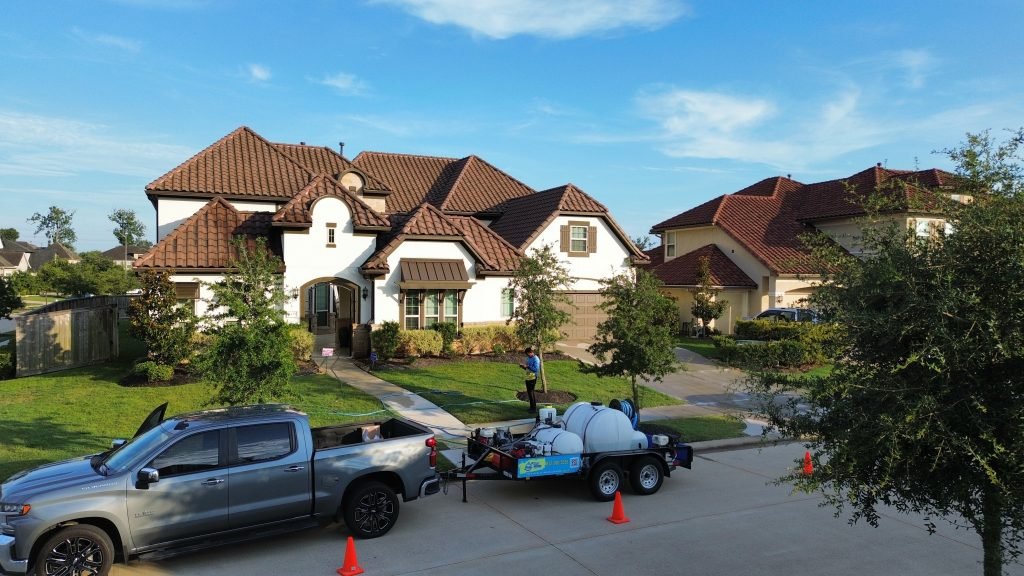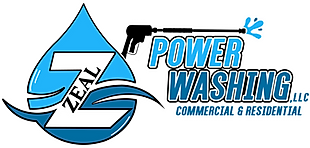1. What is Pressure Washing?
Pressure washing is a cleaning method that involves the use of a mechanical sprayer to expel water at high pressures. This forceful stream of water is effective in removing stubborn stains, grime, and mold from various surfaces such as driveways, sidewalks, and exterior walls.
The intense pressure generated by the equipment makes pressure washing particularly suitable for heavy-duty cleaning tasks where a powerful force is needed to achieve thorough and efficient results. However, it’s essential to use caution and assess the suitability of this method for specific surfaces, as the high pressure can potentially cause damage to delicate materials.

2. Is Soft-Washing Better than Pressure Washing?
Pressure washing and soft washing are distinct cleaning methods with unique advantages. Pressure washing expels water at high pressures, effectively removing tough stains and mold but may damage delicate surfaces.
Soft washing, using low-pressure water and specialized solutions, is ideal for painted exteriors, roofs, and sensitive landscapes. It prevents damage while effectively removing dirt and contaminants. Choose based on specific cleaning needs and surface sensitivity.
Soft washing is the preferred method for delicate surfaces prone to damage. Suitable for painted exteriors, roofs, and wood, it removes dirt and mold without causing harm. Recommended for landscaping, the lower pressure protects plants. For surfaces requiring a gentle touch or when considering vegetation well-being, soft washing is the ideal choice.
3. Surface Material
Identifying the surface material is crucial before pressure washing to ensure the appropriate cleaning approach. Begin by visually inspecting the surface and checking any available documentation or labels.
Some materials can handle more pressure than others. Concrete and brick can handle more pressure than wood or certain types of siding. If unsure, try a small test area in a hidden spot to see how the material responds to the pressure washer.
Once you identify the surface material, adjust the pressure washer settings accordingly. Start with low pressure and increase as needed. Use lower pressure for soft surfaces to avoid damage, and higher pressure for tough stains on hard surfaces.
Stay a safe distance away, usually 2 to 3 feet, and keep the nozzle at the same angle for even cleaning. Check the pressure’s effect on the material and change settings if needed to clean well without damaging the surface.

4. What to Wash and What NOT to Wash
Certain surfaces should be excluded from pressure washing to prevent harm. Delicate surfaces such as painted exteriors, wooden siding, and landscaping features should be treated with more caution, opting for gentler methods like soft washing. Windows, electrical outlets, fixtures, and roofs are other areas where pressure washing is not recommended due to the risk of damage or water infiltration.
Furthermore, sensitive plants and landscaping should be protected from the force of the pressure washer, as high-pressure water can cause harm to vegetation and disturb soil. Always assess materials carefully, adjust pressure settings accordingly, and follow safety guidelines to ensure a successful and damage-free pressure washing process.
As mentioned Previously, When pressure washing, it’s important to be selective about what to wash and what to avoid to prevent damage and ensure effective cleaning. Focus on hard exterior surfaces like concrete driveways, sidewalks, and brick walls, as pressure washing is highly effective for removing built-up dirt and grime from these durable materials. Decks, patios, fences, and outdoor furniture made of metal or plastic can also benefit from pressure washing to revitalize their appearance.
Here are some of the most common things you can do Pressure Washing –
- Driveway and Sidewalk Cleaning: Remove dirt, stains, and grime from concrete surfaces.
- House Exterior Cleaning: Safely clean exterior walls, siding, and facades.
- Roof Cleaning: Remove moss, algae, and stains from roofing materials.
- Deck and Patio Cleaning: Restore wooden or concrete decks and patios to their original condition.
- Fence Cleaning: Eliminate dirt and mildew to revitalize fences.
- Gutter Cleaning: Clear debris and buildup from gutters for proper drainage.
- Concrete Surface Cleaning: Clean various concrete surfaces, including garages, parking lots, and pathways.
- Brick and Masonry Cleaning: Remove dirt and stains from brick walls and masonry.
- Vehicle and Equipment Cleaning: Clean cars, trucks, boats, and outdoor equipment.
- Commercial Building Cleaning: Provide power washing services for commercial properties.
- Graffiti Removal: Remove graffiti from various surfaces using pressure washing techniques.
- Patio Furniture Cleaning: Clean outdoor furniture made of metal, plastic, or other materials.
- Pool Deck Cleaning: Remove algae and stains from pool decks and surrounding areas.
- Warehouse and Industrial Cleaning: Clean large industrial spaces, including warehouses and factories.
- Awnings and Canopy Cleaning: Safely clean and restore awnings and canopies.
- Window Washing Preparation: Pre-cleaning windows with a gentle spray before traditional window washing.
- Residential Exterior Cleaning Packages: Offer comprehensive exterior cleaning services for homes.
- Mold and Mildew Removal: Use pressure washing to eliminate mold and mildew on various surfaces.
- Emergency Cleanup Services: Provide quick response for urgent cleaning needs.
- Annual or Seasonal Maintenance Plans: Offer scheduled maintenance to keep surfaces clean year-round.
5. Should you Pressure Wash or Hire a Professional?
Deciding whether to hire a professional pressure washer or tackle the task on your own involves weighing various factors. DIY pressure washing can be cost-effective, especially for smaller projects, and provides a sense of accomplishment. However, it requires investing in equipment, understanding pressure settings, and being mindful of potential damage to surfaces. For larger or more complex tasks, hiring a professional brings expertise and efficiency. Professionals have the experience to adjust pressure levels based on surfaces, use appropriate cleaning agents, and ensure a thorough and safe cleaning process. This option saves time, guarantees quality results, and minimizes the risk of accidental damage.
On the other hand, DIY pressure washing can be a rewarding endeavor for individuals who enjoy hands-on projects and have the time to invest in learning the proper techniques. It is crucial, however, to educate oneself on the equipment and take necessary safety precautions. Hiring a professional is ideal for those who prioritize convenience and want assurance that the job will be done correctly. Ultimately, the choice between DIY and professional pressure washing depends on the scope of the project, individual skill level, and the importance of achieving optimal results without the learning curve associated with the equipment and techniques involved.
By leveraging Google’s search capabilities and utilizing online resources, you can identify and choose a reputable pressure washing company that meets your specific needs and ensures a successful and professional cleaning job. Simply search things like Pressure Washing Near Me, Roof Cleaning, or the specific service your looking for.

6. Pressure Washing can be Dangerous, Be Safe!
The slender stream from a power/pressure washer seems harmless but exerts up to 2,000 pounds of force, posing serious dangers. Avoid spraying near outlets and never aim at people. Prioritize safety with goggles, maintaining 5-to-6 feet distance. Start at the lowest setting and test on hard surfaces before soft materials.
Clean vertical surfaces top-to-bottom to prevent dirty water cascading. Use safety gear and secure outlets. Apply a cleaning solution, let it soak, and rinse. For larger areas, consider hiring a commercial power washing company. When renting, request a demo, choose the right nozzle, and prioritize safety. Vigilance is crucial for a secure power/pressure washing experience.
7. Cleaning Agents
Various cleaning agents can be employed in the pressure washing or soft washing process to address specific cleaning challenges and enhance overall effectiveness. Here are some commonly used cleaning agents:
- Degreasers: Effective for removing oil, grease, and tough stains, making them ideal for commercial settings.
- Mildewcides: Essential for combating mold and mildew on exterior surfaces, ensuring a longer-lasting clean.
- Biodegradable Detergents: Versatile and eco-friendly, suitable for both pressure washing and soft washing on various surfaces.
- Oxalic Acid Cleaners: Specifically useful for rust stain removal from surfaces like concrete, wood, or vinyl siding.
- Wood Cleaners: Tailored for soft washing wooden surfaces, such as decks and fences, effectively removing dirt and mildew.
It’s crucial to read and follow manufacturer instructions when using cleaning agents to ensure safety and efficacy. Additionally, considering the environmental impact and choosing eco-friendly options when applicable contributes to responsible cleaning practices. Customizing the cleaning agent based on the surface type and specific cleaning requirements ensures a successful and efficient pressure washing or soft washing process.

